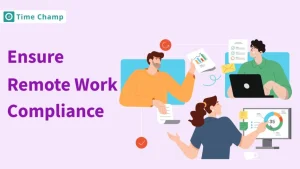Many remote teams face challenges in maintaining clear and effective communication. A weak communication culture in remote teams can lead to misunderstandings, delays, and disengagement. Without the right approach, collaboration suffers, and productivity declines.
In this blog, you will explore some best strategies help to build a strong communication culture in remote teams which creates a more connected and productive work environment. Let’s dive in!
Why Communication Culture Matters in Remote Teams
Work gets done quickly when remote employees can exchange information, collaborate in problem-solving, and provide timely updates on task status. An effective communication culture helps reduce errors and misunderstandings, permitting workflow continuity without interruption. It also builds good team spirit, keeping the remote workers engaged and aligned with the company’s goals.
Poor interaction can create challenges for virtual teams. Lack of clarity may lead to missed deadlines, reduced efficiency, and frustration. Team members might feel disconnected, affecting morale and overall performance. Establish clear communication guidelines, promote transparency, and encourage regular check-ins to create a productive and supportive remote work environment.
How to Build a Communication Culture in Remote Teams
Team communication and collaboration in different locations are crucial. Let’s take a look at some of the best tips for creating a healthy communication culture in a remote environment where everyone stays in touch and works well together.
Step 1: Define Your Communication Goals
Define what your team should communicate, including work updates, problems, and major decisions. Discuss who needs specific updates. Some information may be for managers, while another may be for project team members. Select appropriate channels, either meetings, emails, or message platforms.
At the same time, should give time zones for the updates, ranging from daily check-in meetings to weekly discussions and monthly reviews. These expectations will allow the various team members to communicate effectively, promoting smooth collaboration and reducing misunderstandings.
Step 2: Choose the Right Tools
Choose the best communication methods based on your team’s sharing needs. Instant chat apps for quick messages, email for longer discussions, and video conference calls for important meetings. Using different tools for different types of communication helps get the work done while helping your remote team members work better with each other.
You can rely on task management tools to follow the work progress and the due dates so that everyone stays on track. When teams have the proper tools available to them, they can quickly share updates. This means that there will be little room for delays generated from mixed-up or lost messages among team members.
Step 3: Establish Communication Guidelines
Let the workers know precisely how to communicate with each other. Specify how quickly the responses should be, what medium to use for sending different types of messages, and when meetings will be held. Having these rules allows better compatibility while working together.
Help people share information in an organized manner so that no one gets too many messages and everyone understands the content of those messages. Knowing the proper channel for communication helps in smooth operation and eases the work for the entire team.
Step 4: Foster Trust and Transparency
Create an environment where team members feel safe to speak freely with one another. Encourage them to share their ideas, ask questions when they need assistance, and communicate what they feel. When people can express their minds in the workplace, they grow closer as a team and learn to understand each other better.
An open work environment encourages a sense of belonging for employees. Therefore, if team members trust each other, they can work collaboratively and accomplish more. Therefore, a whole team becomes stronger and successful in their jobs.
Step 5: Train Your Team
Teach your team about how to use online tools, write clear messages, and participate in online meetings. Make sure that they understand how to communicate their opinions in simple terms that everyone understands. This reduces confusion regarding what someone else is trying to say.
If team members possess good communication and writing skills, they will work together more effectively. Adequate communication decreases the time spent in completing a task and enhances the chances of completing it without mistakes. Teaching communication and writing skills will strengthen the team and enable it to achieve greater success in their daily work.
Step 6: Regularly Evaluate and Improve
Assess your team’s communication and collaboration regularly. Ask for feedback concerning what are the problems they have at work in meeting deadlines. Correct any problems you find to improve team functionality and clarify communication.
The way everybody keeps in touch has to change as more people join. All of these alterations should ensure that work goes without interruption and that everyone remains interested in doing their best. Listen to your team’s needs and modify plans that will assist them in achieving success.
Key Challenges of Remote Team Communication
Effective communication is essential for remote teams, but working from different locations brings unique challenges. Recognizing these challenges helps in finding better ways to improve teamwork and productivity.
Lack of Face-to-Face Interaction
Working remotely means you miss in-person conversations. Without direct contact, it’s harder to build relationships and trust. Small gestures, like a smile or nod, are absent, making it difficult to read emotions. This can lead to misunderstandings and reduced engagement. Regular video meetings can help bridge this gap and create stronger connections.
Time Zone Challenges
Remote teams often work from different locations, making real-time discussions a challenge. When one member starts their day, another might be logging off. Waiting for replies slows progress and affects decision-making. Using shared calendars and overlapping work hours can improve coordination. Clear deadlines and efficient tools help manage tasks smoothly.
Over-Reliance on Text-Based Communication
Messaging apps and emails are useful, but they lack tone and emotion. Important details might be overlooked, and responses can be misinterpreted. Without vocal cues, a simple message may sound harsh or unclear. Mixing communication methods like voice calls and video chats can make exchanges more effective.
Misinterpretations and Lack of Context
Without visual and verbal cues, written messages can be confusing. A simple statement might be taken the wrong way, causing unnecessary issues. Without background details, team members may struggle to understand the full picture. Providing clear explanations, adding examples, and asking for clarification can reduce confusion.
Tools to Enhance Communication in Remote Teams
Using the right tools makes teamwork easier, even when working from different locations. The right platforms help you stay connected, share updates, and collaborate smoothly. Below are some essential tools that improve remote communication.
Slack for Instant Messaging
Slack allows quick and easy conversations with your team. You can create different channels for projects, departments, or general discussions. This keeps messages organized and easy to find. The platform also supports file sharing, integrations with other apps, and direct messaging, making daily work more efficient.
Zoom or Google Meet for video calls
Face-to-face discussions are important, even in a remote setup. Zoom and Google Meet allow you to hold virtual meetings, helping team members interact in real-time. Video calls improve understanding, strengthen relationships, and reduce confusion. Screen sharing and recording features also make it easier to explain ideas and review discussions later.
Loom for asynchronous video updates
Loom is a great tool for sharing updates without scheduling meetings. It lets you record videos to explain tasks, give feedback, or provide instructions. Team members can watch these recordings at their convenience, helping everyone stay informed without disrupting work schedules. This tool is especially useful for teams working in different time zones.
track, manage, and optimize remote team's performance effortlessly using Time Champ today!
Signup for FreeBook DemoConclusion
Building a strong communication culture in remote teams takes effort, but it leads to better teamwork and productivity. Clear goals, the right tools, and well-defined guidelines help create a smooth workflow. Encouraging trust, regular training, and continuous improvement make collaboration easier. By addressing challenges and using effective platforms, you can keep your team connected and engaged. Strong communication ensures success, no matter where your team members are.
Frequently Asked Questions
Team engagement improves with virtual social events, recognition of achievements, and casual conversations. Encouraging open discussions, providing learning opportunities, and fostering a supportive culture also help.
Teams should use clear and concise messaging, ask for clarification when needed, and handle complex discussions via video or voice calls. Active listening and assuming positive intent help resolve misunderstandings.
Different time zones and cultural norms can cause delays or misunderstandings. Using async communication, scheduling meetings fairly, and fostering cultural awareness help teams collaborate effectively.
Signs include frequent misunderstandings, slow responses, over-reliance on meetings, low engagement, and team members feeling disconnected. Addressing these early can prevent bigger issues.
Communication effectiveness can be measured through team feedback, response times, engagement levels, and project progress. Regularly reviewing communication practices helps improve efficiency and collaboration.






